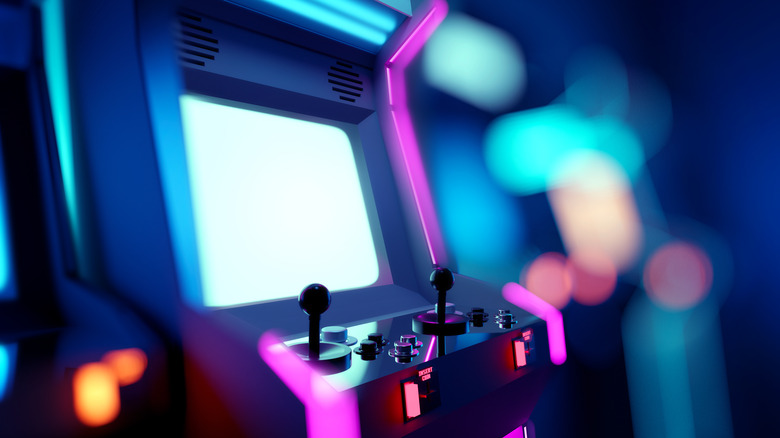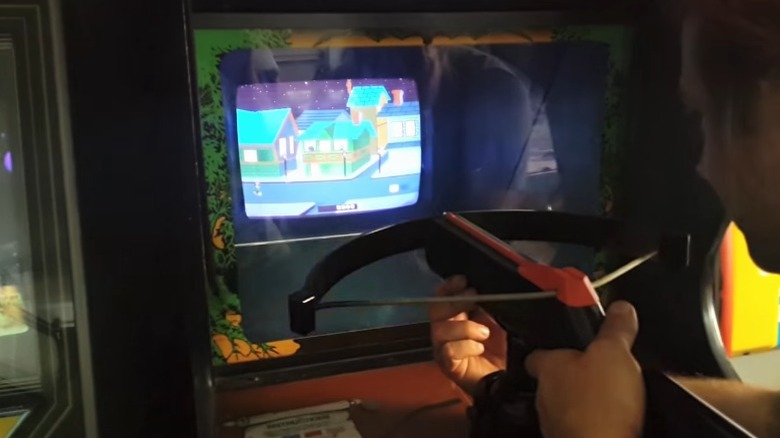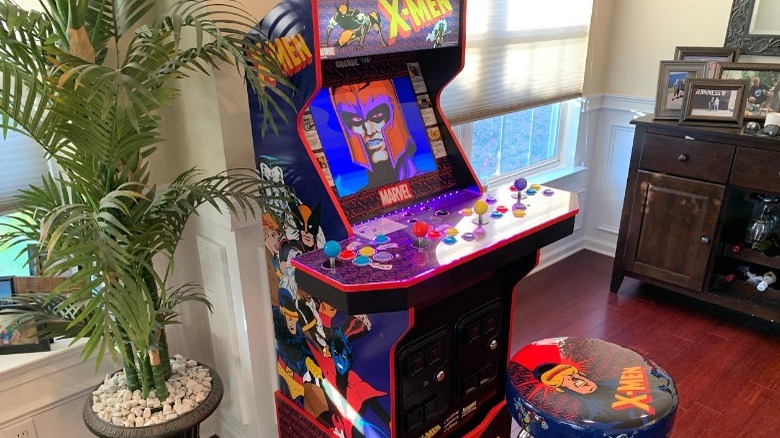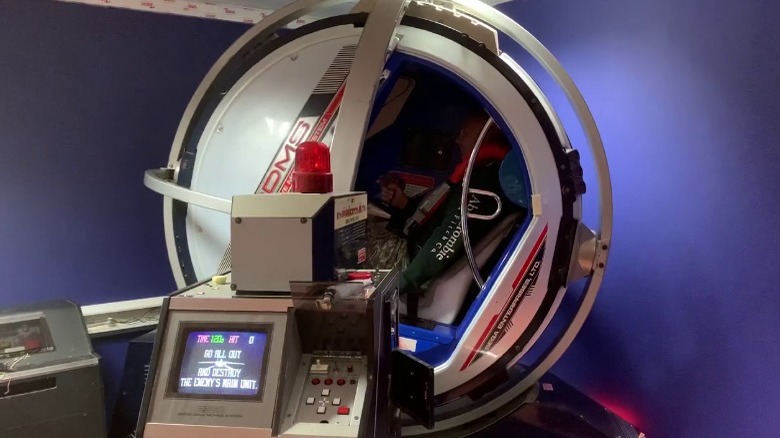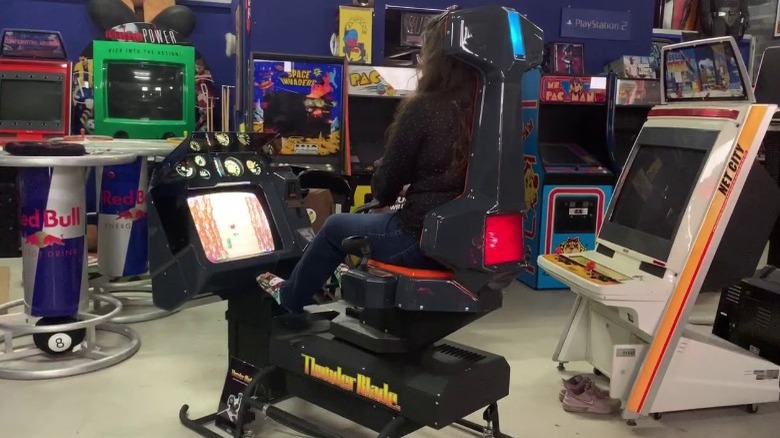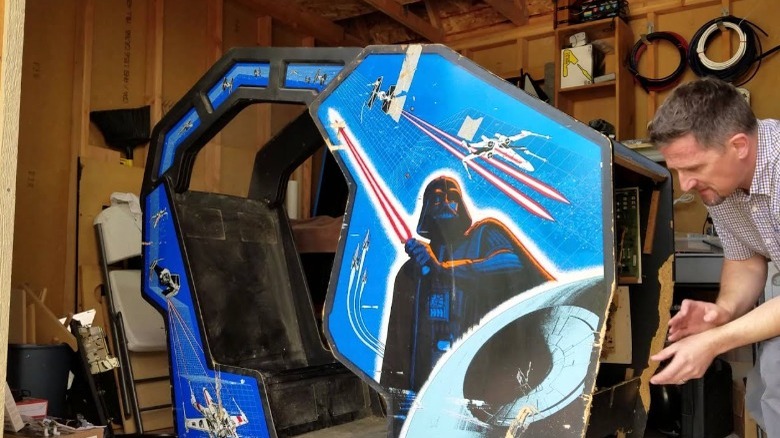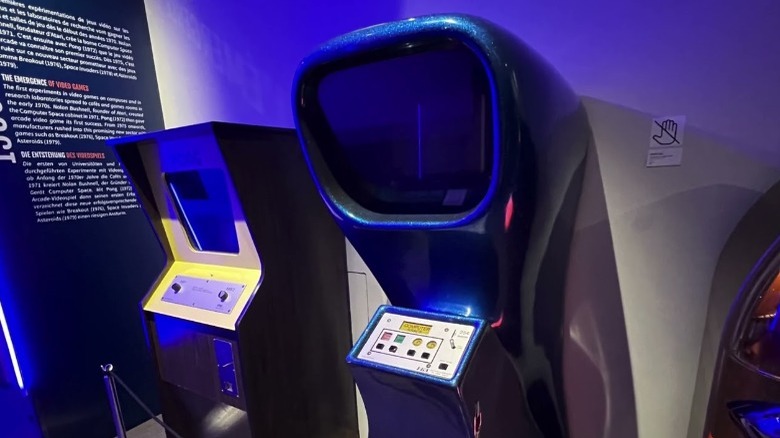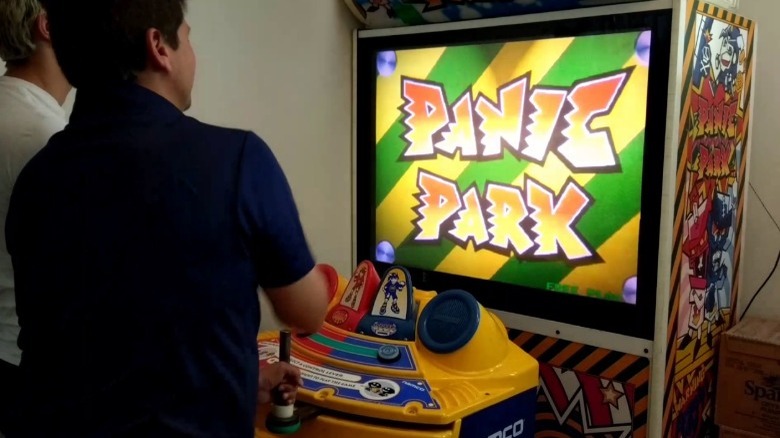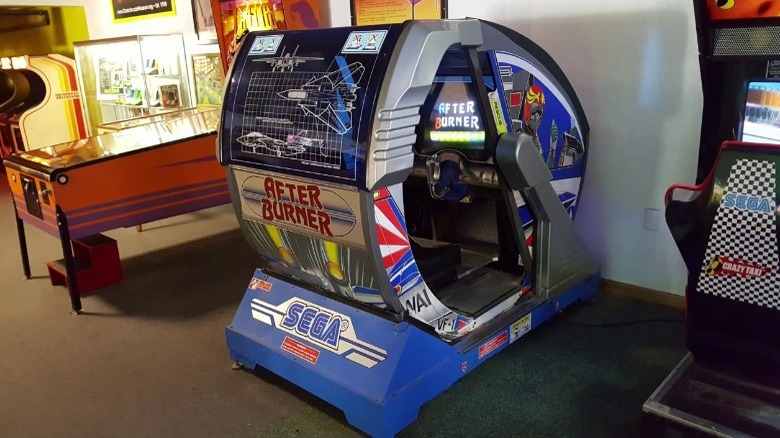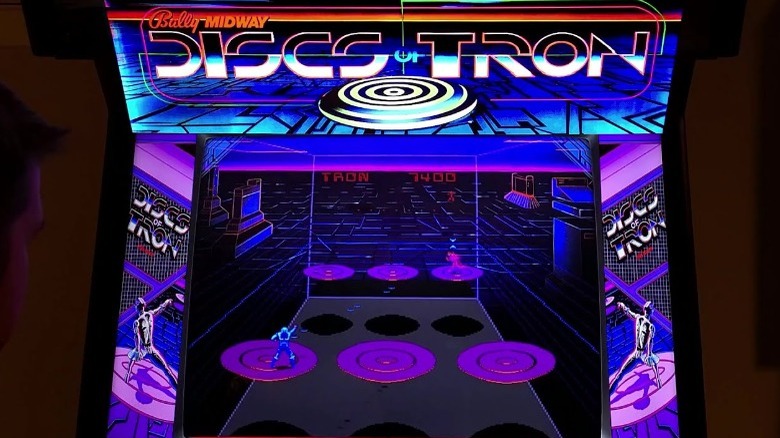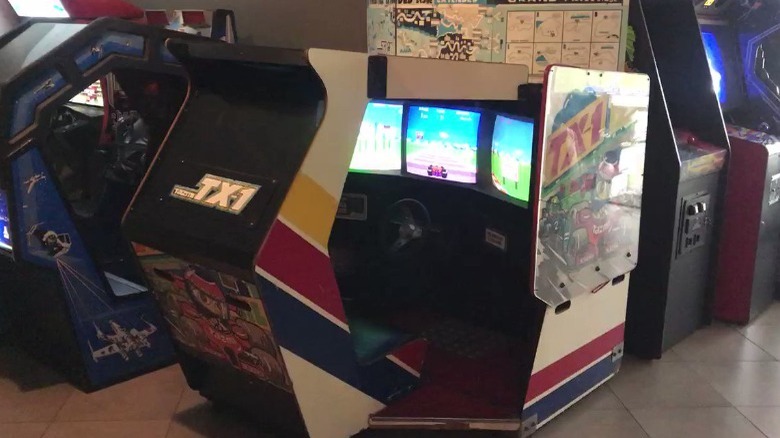10 Of The Coolest Vintage Arcade Machines Of All Time
To modern gamers, arcade machines might seem like nothing more than novelty items. Now that malls and arcades have largely disappeared, you'll likely only see these cabinets in locations like bars and movie theaters. That means only the most popular arcade games will still be around, as the larger, more elaborate machines are not practical for these locations.
Yet, arcade games had a huge role to play in the video game industry. During the '70s and '80s, in particular, they were often the only way to experience a wide array of video games, as home consoles and cartridges were incredibly expensive. In that era, arcades were jam-packed and hugely successful. It was also a time when developers would experiment with the design of cabinets in the hope of standing out from the crowd.
While you'll know popular releases like "Space Invaders," "Pac-Man," and "Donkey Kong," these were traditional stand-up machines that largely looked and played the same. That wasn't always the case, though, and many cabinets had unique features or bizarre looks. Here are some of the coolest and most distinctive arcade machines that were ever made.
Crossbow
First released in 1983, "Crossbow" is a light gun shooter that uses a fixed controller in the shape of a crossbow. That light gun design, which looks just like the real thing and is even the correct size, makes the cabinet immediately jump out from the crowd. After all, not every machine featured a full-size crossbow attached to the front. Created by Exidy, the game would later be ported to various other platforms, including the Commodore 64 and Atari 2600. It was also designed to be easily converted post-release with new games and themes.
"Crossbow" effectively tasked the player with protecting a group of adventurers who moved sideways across the screen. A variety of enemies would attempt to attack the NPC characters, and the player would shoot them with the crossbow before they could cause any damage. From here, it was possible to choose what location to visit next from a range of options. The gameplay would continue in a similar manner until the game was completed, with new adventurers added to the roster after each completed round. This made it harder to protect them all, as there were more targets for enemies to shoot. The good guys could also be hit by the player, causing them to walk slower to make the game more challenging.
The arcade cabinet was well received when it launched. Trade magazine Play Meter praised the gameplay while also noting that it was expensive to play, with players forced to regularly add more money to continue playing. In a retrospective look back at arcade games, Flux named it among the top 100 ever released.
X-Men Arcade
Side-scrolling beat 'em up games were some of the more popular genres in arcades around the world. Just look at the likes of "Final Fight," "Teenage Mutant Ninja Turtles," and "Streets of Rage" for proof of that. So, the genre was a good choice for many established properties when developers adapted them to the world of video games. One of the better examples of this was the 1992 release "X-Men." Developed and published by Konami, the game is largely based on the earlier animated television series "X-Men: Pryde of the X-Men."
As you might expect, the game follows the X-Men as they battle against the forces of supervillain Magneto. Playable characters included Cyclops, Wolverine, and Storm, who progressed through a series of levels until they eventually reached Magneto himself on his secret Asteroid M base. The gameplay was familiar to any beat 'em up fans, with the joystick used for movement and three buttons used for attacking, jumping, and activating special mutant powers.
What makes this particular arcade machine stand out is that it came in multiple forms. There were standard two-player and four-player editions of the cabinet sold to arcades, as well as a special six-player machine. This allowed up to six players to take part in a round simultaneously and also had two screens to help give a wider view of the action. Those who never got the chance to experience "X-Men" in arcades had the opportunity to play it when it was ported to both PlayStation 3 and Xbox 360 in 2010.
Sega R360
Some of the more elaborate arcade machines feature a sort of cockpit to enclose the player. This was done to create a more immersive experience and help arcade cabinets stand out from their many rivals. Sega's R360 was a little different from the standard examples you'd likely find in malls up and down the country, though. This particular arcade game launched in Japan in 1990 and then made its way to international markets the following year, and was followed up by a successor in the form of the R360Z.
An estimated 200 units were produced in total, making it something of a rarity — although this was likely due to the size and expense of the cabinet compared to other arcade machines. It needed more than four meters of floor space and an industrial-grade power supply, so it was less convenient for arcade operators to install. All of that was needed because the machine had the ability to rotate on its axis a full 360 degrees in every direction.
Two separate games could be installed on the R360 — "G-LOC: Air Battle" and "Wing War" — both of which were aerial-based combat titles. Depending on the action on the screen, the machine would rotate to match the movement of the player's aircraft. Due to the fact that it could move in so many directions, players had to be strapped in using a safety harness, and the machine also came equipped with emergency stop buttons in case of any accidents.
Thunder Blade
Who wouldn't want the opportunity to live out their childhood dreams and pilot a helicopter as they destroy enemy forces and save innocent civilians? That's exactly what the third-person shoot 'em up "Thunder Blade" provides. The Sega arcade game, which has since been ported to a wide array of platforms — including the Commodore 64 and Nintendo 3DS — first started showing up in arcades at the end of 1987. Like many of Sega's other game cabinets, it utilizes motion simulation so that the entire machine moves in response to the on-screen action.
The game was released in two distinct versions. The first was a traditional stand-up arcade machine that included a joystick, while the second resembled a helicopter cockpit that players could enter and sit down in. Both variants offered force feedback through the joystick, but the sit-down model would also move around to simulate the helicopter's in-game movement. The premise of the game was inspired by the 1983 film "Blue Thunder."
Gameplay is fairly similar to other helicopter arcade games. Some levels are played from a top-down perspective and others take place with a view set behind the helicopter. In either case, the aim is to destroy enemies using a chain gun and special weapons like missiles to advance to the next stage. The unique look and motion-enabled machine made it one of the most popular cabinets in the months after it was released.
Star Wars Cockpit
As one of the biggest and most successful media franchises in history, there have been countless "Star Wars" games over the years. That includes a wide array of arcade games that began with the 1983 rail shooter. Known simply as "Star Wars," it was developed by Atari and later saw ports arrive on home consoles such as the Atari 2600, ZX Spectrum, and Commodore 64. Unlike future games in the series, this edition features vector graphics and was a strictly single-player experience.
"Star Wars" was available as an upright stand-up machine and as a cockpit cabinet, which players could sit in and pilot as if they were in an X-Wing. With its distinctive art style on the outside and familiar music, this was an arcade machine that was attractive and satisfying to play. The gameplay revolved around attacking the Death Star and had three distinct phases as the player battled against TIE Fighters in an X-Wing as Luke Skywalker. Each round culminated in an attempt to destroy the space station by firing a proton torpedo into its exhaust port, which would reset the action at the first phase while bumping up the difficulty.
The game proved to be a success for Atari, with the company producing more than 10,000 cabinets across the United States and Ireland. It is also highly regarded in the industry and has been listed among the top arcade games by the likes of Flux magazine. The same arcade machines could be converted to work with the release of "The Empire Strikes Back" in 1985.
Computer Space
"Computer Space" holds a special place in gaming history as it is one of the earliest video games, and the first to be commercially available in arcades. Developed by some of the key people who would go on to found Atari and later work on the game "Pong," it was a space combat title that took inspiration from the earlier "Spacewar!" Like that game, players controlled a small rocket that could shoot incoming flying saucer enemies with missiles. The rocket could be rotated to change its direction and accelerate forward in addition to firing its main weapon, with the ultimate goal being to get a higher score than the CPU.
What really makes "Computer Space" stand out is its unique cabinet design. As the first proper video game arcade, the developers didn't have any particular standard design to stick to, giving rise to the futuristic sci-fi shape. The "Computer Space" arcade machine very much looked as if it had been taken off some sort of alien craft, and came in a variety of bold, bright colors. It also had no joystick and instead relied completely on buttons to control the player ship and fire the missiles.
The arcade game was a financial success and sold more than a thousand units in the months after it was first made available. However, it wasn't the huge hit that publisher Nutting Associates had been hoping for, and this was partly blamed on the complex controls and lack of explanation for what players were expected to do.
Panic Park
Unlike many of the other arcade games in this article that are from the '70s and '80s, "Panic Park" is a relatively modern arcade game. First hitting arcades in May 1998 in Japan and the rest of the world in the following months, it was a multiplayer-focused title that involved a variety of mini-games. The gameplay revolves around completing set challenges before your opponent, with the winner determined by who can accumulate the most medals.
Anyone who has seen a "Panic Park" cabinet will have noticed that it has a rather unusual controller. Essentially a large rubber joystick, it is moved along a horizontal slider that controls the player's character on screen. Most of the mini-games focus on collecting items or avoiding potential hazards by moving the joystick sideways. However, "Panic Park" allows players to have a direct impact on their competitors as they can use their joystick to bump into their opponent. This can cause them to miss important objects or even hit an obstacle.
Although many arcade games pit players against each other, few actually include real-life physical attacks as part of the gameplay. That's what makes "Panic Park" such an interesting and cool cabinet, as it expands the game from the screen in a way that is usually not possible.
After Burner
In many ways, "After Burner" is a continuation of the concept Sega used for its earlier game "Thunder Blade." However, while that title tasked players with piloting an attack helicopter, this 1987 rail shooter instead put them into the cockpit of a fighter jet. Played from a third-person perspective, users have to pilot their F-14 Tomcat jet as they attack enemies and avoid obstacles in various stages. To complete their missions, players have access to a machine gun and missiles that are capable of tracking enemy fighters.
Like many of Sega's other arcade releases, "After Burner" came in multiple varieties. The standard and most widespread was a traditional stand-up cabinet that players would play in an upright position. However, there was also a larger deluxe model that simulated a cockpit. This variant featured full flight controls, a built-in surround sound system, and a strap to keep the player secured in their seat. That proved an important feature as the cockpit machine was capable of moving, both side to side and backward and forward, in conjunction with the on-screen action.
"After Burner" quickly became one of the most successful arcade games around the world after its release, outgrossing many of its main competitors over the course of the next year. It was subsequently ported to a wide array of other platforms due to its popularity, finding success on consoles like the Master System, Sega Saturn, and Commodore 64.
Discs of Tron
Based on the hit Disney movie franchise, "Discs of "Tron" is an arcade game that was released in 1982. Designed and published by the company that would become Midway Games, it adapts the disc battles in "Tron" to video game form. Those who have seen the film will likely recall the scenes featuring a combat sport that resembles jai alai, which sees the characters attempt to hit each other with flying discs. The game puts players into a similar situation as they take control of Tron in a battle against sark.
As was common with arcade games in the '80s and '90s, "Discs of Tron" came in several variants. The most common was the standard stand-up cabinet, but there was also a larger semi-enclosed machine. This version of "Discs of Tron" was far more stylish than its more traditional variant and also fit more closely with the aesthetic of the franchise. Users would stand inside the machine and be bombarded with lights and electronic sounds.
While the original "Tron" arcade game was a huge hit, "Discs of Tron" failed to emulate that success. A flop, it was made in far fewer numbers than its predecessor and has become something of a collector's item in recent years. Some versions of the arcade game have sold for as much as $11,000 and they are rare to find.
TX-1
"TX-1" is a racing simulator that first arrived in arcades in 1984. Created by the Japanese company Tatsumi, it was released in the U.S. and Europe by Atari. Taking inspiration from Formula 1, the game tasks players with reaching set checkpoints on a racetrack as quickly as possible. If successful, the round would continue, and players would have the chance to pick between two directions. This would determine what tracks would become available in later stages, many of which were based on famous real-life Formula 1 courses.
Unlike many other racers, "TX-1" had a heavy focus on realism. That meant that the developers focused on trying to make the entire experience feel as close to real-life racing as possible. This includes adding force feedback to the steering wheel to provide the player with a feeling for the car, in addition to styling the entire cabinet to be more like a car. By far the biggest adjustment to the design compared to other racing games was the three-screen setup.
The idea behind this was that it would allow players to see more of the in-game world and the experience would be made more immersive by surrounding the player with visuals. The main screen was positioned directly in front of the player, with two screens placed on either side at 30-degree angles. This made the arcade machine much larger than many other cabinets. Although this likely limited its overall sales, the reception to "TX-1" was still positive and it performed well commercially.
